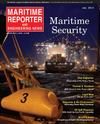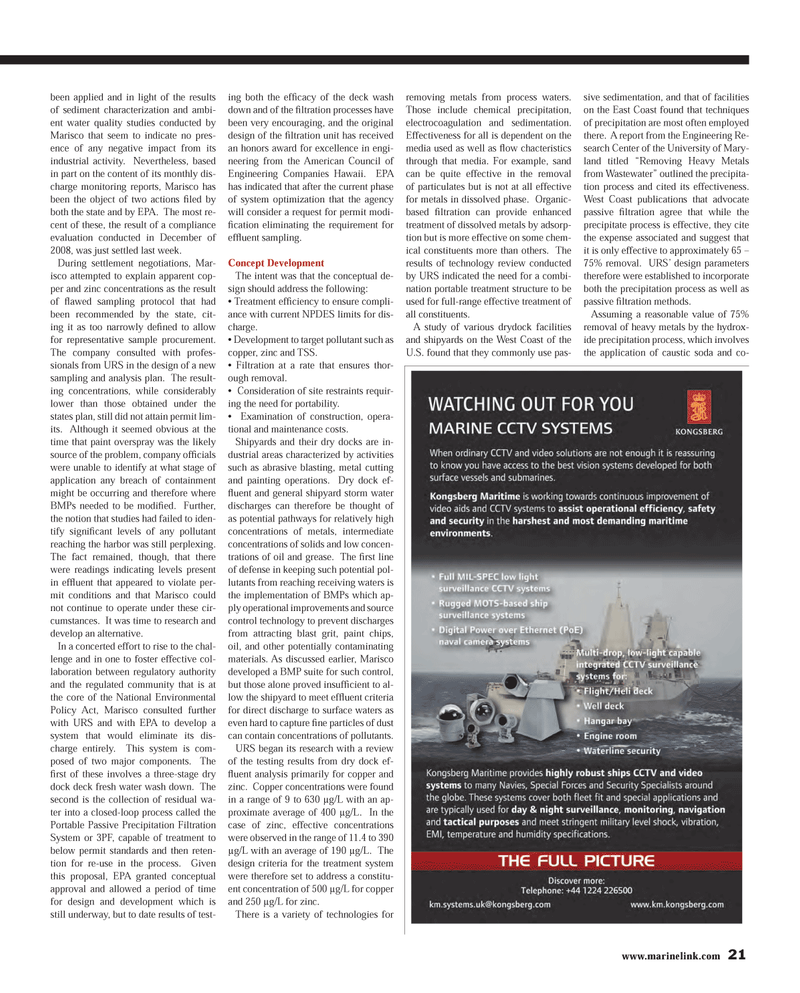
Page 21: of Maritime Reporter Magazine (July 2013)
Maritime Security Edition
Read this page in Pdf, Flash or Html5 edition of July 2013 Maritime Reporter Magazine
been applied and in light of the results of sediment characterization and ambi-ent water quality studies conducted by Marisco that seem to indicate no pres-ence of any negative impact from its industrial activity. Nevertheless, based in part on the content of its monthly dis-charge monitoring reports, Marisco has been the object of two actions Þ led by both the state and by EPA. The most re- cent of these, the result of a compliance evaluation conducted in December of 2008, was just settled last week.During settlement negotiations, Mar- isco attempted to explain apparent cop-per and zinc concentrations as the result of ß awed sampling protocol that had been recommended by the state, cit-ing it as too narrowly deÞ ned to allow for representative sample procurement. The company consulted with profes-sionals from URS in the design of a new sampling and analysis plan. The result- ing concentrations, while considerably lower than those obtained under the states plan, still did not attain permit lim-its. Although it seemed obvious at the time that paint overspray was the likely source of the problem, company ofÞ cials were unable to identify at what stage of application any breach of containment might be occurring and therefore where BMPs needed to be modiÞ ed. Further, the notion that studies had failed to iden-tify signiÞ cant levels of any pollutant reaching the harbor was still perplexing. The fact remained, though, that there were readings indicating levels present in efß uent that appeared to violate per- mit conditions and that Marisco could not continue to operate under these cir- cumstances. It was time to research and develop an alternative.In a concerted effort to rise to the chal- lenge and in one to foster effective col- laboration between regulatory authority and the regulated community that is at the core of the National Environmental Policy Act, Marisco consulted further with URS and with EPA to develop a system that would eliminate its dis-charge entirely. This system is com- posed of two major components. The Þ rst of these involves a three-stage dry dock deck fresh water wash down. The second is the collection of residual wa-ter into a closed-loop process called the Portable Passive Precipitation Filtration System or 3PF, capable of treatment to below permit standards and then reten-tion for re-use in the process. Given this proposal, EPA granted conceptual approval and allowed a period of time for design and development which is still underway, but to date results of test- ing both the efÞ cacy of the deck wash down and of the Þ ltration processes have been very encouraging, and the original design of the Þ ltration unit has received an honors award for excellence in engi-neering from the American Council of Engineering Companies Hawaii. EPA has indicated that after the current phase of system optimization that the agency will consider a request for permit modi-Þ cation eliminating the requirement for efß uent sampling. Concept DevelopmentThe intent was that the conceptual de-sign should address the following:? Treatment ef Þ ciency to ensure compli- ance with current NPDES limits for dis-charge. ? Development to target pollutant such as copper, zinc and TSS. ? Filtration at a rate that ensures thor- ough removal.? Consideration of site restraints requir- ing the need for portability. ? Examination of construction, opera-tional and maintenance costs.Shipyards and their dry docks are in-dustrial areas characterized by activities such as abrasive blasting, metal cutting and painting operations. Dry dock ef-ß uent and general shipyard storm water discharges can therefore be thought of as potential pathways for relatively high concentrations of metals, intermediate concentrations of solids and low concen-trations of oil and grease. The Þ rst line of defense in keeping such potential pol-lutants from reaching receiving waters is the implementation of BMPs which ap-ply operational improvements and source control technology to prevent discharges from attracting blast grit, paint chips, oil, and other potentially contaminating materials. As discussed earlier, Marisco developed a BMP suite for such control, but those alone proved insufÞ cient to al- low the shipyard to meet efß uent criteria for direct discharge to surface waters as even hard to capture Þ ne particles of dust can contain concentrations of pollutants.URS began its research with a review of the testing results from dry dock ef-ß uent analysis primarily for copper and zinc. Copper concentrations were found in a range of 9 to 630 �?g/L with an ap- proximate average of 400 �?g/L. In the case of zinc, effective concentrations were observed in the range of 11.4 to 390 �?g/L with an average of 190 �?g/L. The design criteria for the treatment system were therefore set to address a constitu-ent concentration of 500 �?g/L for copper and 250 �?g/L for zinc. There is a variety of technologies for removing metals from process waters. Those include chemical precipitation, electrocoagulation and sedimentation. Effectiveness for all is dependent on the media used as well as ß ow chacteristics through that media. For example, sand can be quite effective in the removal of particulates but is not at all effective for metals in dissolved phase. Organic- based Þ ltration can provide enhanced treatment of dissolved metals by adsorp-tion but is more effective on some chem- ical constituents more than others. The results of technology review conducted by URS indicated the need for a combi-nation portable treatment structure to be used for full-range effective treatment of all constituents.A study of various drydock facilities and shipyards on the West Coast of the U.S. found that they commonly use pas-sive sedimentation, and that of facilities on the East Coast found that techniques of precipitation are most often employed there. A report from the Engineering Re- search Center of the University of Mary-land titled ?Removing Heavy Metals from Wastewater? outlined the precipita- tion process and cited its effectiveness. West Coast publications that advocate passive Þ ltration agree that while the precipitate process is effective, they cite the expense associated and suggest that it is only effective to approximately 65 ? 75% removal. URS? design parameters therefore were established to incorporate both the precipitation process as well as passive Þ ltration methods. Assuming a reasonable value of 75% removal of heavy metals by the hydrox-ide precipitation process, which involves the application of caustic soda and co-www.marinelink.com 21MR #7 (18-25).indd 21MR #7 (18-25).indd 217/1/2013 9:06:43 AM7/1/2013 9:06:43 AM

 20
20

 22
22
